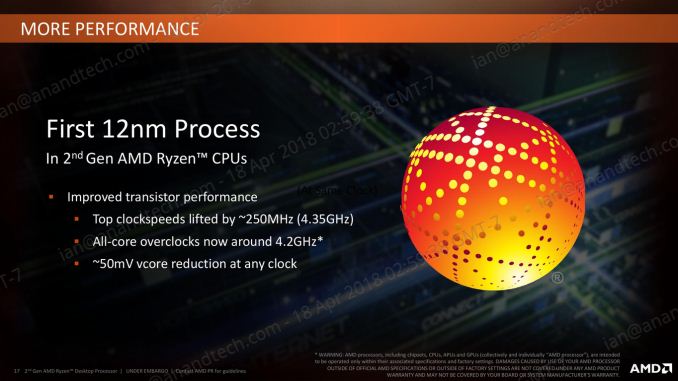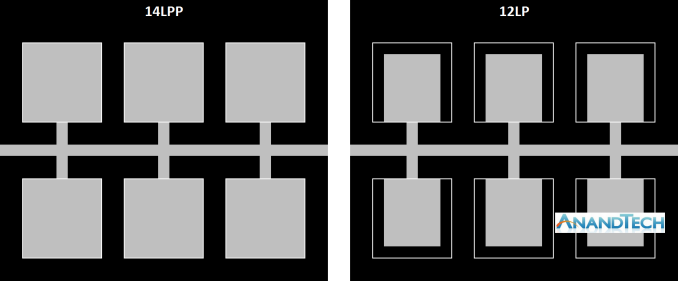The AMD 2nd Gen Ryzen Deep Dive: The 2700X, 2700, 2600X, and 2600 Tested
by Ian Cutress on April 19, 2018 9:00 AM ESTTalking 12nm and Zen+
One of the highlights of the Ryzen 2000-series launch is that these processors use GlobalFoundries’ 12LP manufacturing process, compared to the 14LPP process used for the first generation of Ryzen processors. Both AMD and GlobalFoundries have discussed the differences in the processes, however it is worth understanding that each company has different goals: AMD only needs to promote what helps its products, whereas GlobalFoundries is a semiconductor foundry with many clients and might promote ideal-scenario numbers. Earlier this year we were invited to GlobalFoundries Fab 8 in upstate New York to visit the clean room, and had a chance to interview Dr. Gary Patton, the CTO.
The Future of Silicon: An Exclusive Interview with Dr. Gary Patton, CTO of GlobalFoundries
In that interview, several interesting items came to light. First, that the CTO doesn’t necessarily have to care much about what certain processes are called: their customers know the performance of a given process regardless of the advertised ‘nm’ number based on the development tools given to them. Second, that 12LP is a series of minor tweaks to 14LPP, relating to performance bumps and improvements that come from a partial optical shrink and a slight change in manufacturing rules in the middle-line and back-end of the manufacturing process. In the past this might not have been so news worthy, however GF’s customers want to take advantage of the improved process.
Overall, GlobalFoundries has stated that its 12LP process offers a 10% performance improvement and a 15% circuit density improvement over 14LPP.
This has been interpreted in many ways, such as an extra 10% frequency at the same power, or lower power for the same frequency, and an opportunity to build smaller chips.
As part of today’s launch, AMD has clarified what the move to 12LP has meant for the Ryzen 2000-series:
- Top Clock Speeds lifted by ~250 MHz (~6%)
- All-core overclocks around 4.2 GHz
- ~50 mV core voltage reduction
AMD goes on to explain that at the same frequency, its new Ryzen 2000-series processors draw around 11% less power than the Ryzen 1000-series. The claims also state that this translates to +16% performance at the same power. These claims are a little muddled, as AMD has other new technologies in the 2000-series which will affect performance as well.
One interesting element is that although GF claims that there is a 15% density improvement, AMD is stating that these processors have the same die size and transistor count as the previous generation. Ultimately this seems in opposition to common sense – surely AMD would want to use smaller dies to get more chips per wafer?
Ultimately, the new processors are almost carbon copies of the old ones, both in terms of design and microarchitecture. AMD is calling the design of the cores as ‘Zen+’ to differentiate them to the previous generation ‘Zen’ design, and it mostly comes down to how the microarchitecture features are laid out on the silicon. When discussing with AMD, the best way to explain it is that some of the design of the key features has not moved – they just take up less area, leaving more dark silicon between other features.
Here is a very crude representation of features attached to a data path. On the left is the 14LPP design, and each of the six features has a specific size and connects to the bus. Between each of the features is the dark silicon – unused silicon that is either seen as useless, or can be used as a thermal buffer between high-energy parts. On the right is the representation of the 12LP design – each of the features have been reduced in size, putting more dark silicon between themselves (the white boxes show the original size of the feature). In this context, the number of transistors is the same, and the die size is the same. But if anything in the design was thermally limited by the close proximity of two features, there is now more distance between them such that they should interfere with each other less.
For reference, AMD lists the die-size of these new parts as 213mm2, containing 4.8 billion transistors, identical to the first generation silicon design. AMD confirmed that they are using 9T transistor libraries, also the same as the previous generation, although GlobalFoundries offers a 7.5T design as well.
So is Zen+ a New Microarchitecture, or Process Node Change?
Ultimately, nothing about most of the Zen+ physical design layout is new. Aside from the manufacturing process node change and likely minor adjustments, the rest of the adjustments are in firmware and support:
- Cache latency adjustments leading to +3% IPC
- Increased DRAM Frequency Support to DDR4-2933
- Better voltage/frequency curves, leading to +10% performance overall
- Better Boost Performance with Precision Boost 2
- Better Thermal Response with XFR2













545 Comments
View All Comments
fallaha56 - Thursday, April 19, 2018 - link
I’m not -I’m jst showing how stupid your OP wasIf someone is selling an entry level chip for the same price as someone else’s that’s the comparison
Include the platform costs if you like but that’s what matters -bang for buck
Only for .1% of people does performance at any costs matter
Ninjawithagun - Thursday, April 19, 2018 - link
Actually no. Once again proving you do not know how to count to 8.LurkingSince97 - Thursday, April 19, 2018 - link
Um... NO.Sure, in some cases it is possible to compare two processors of 'equal quality' and then look at cost second.
But that is an impossible task in a review. And for some processors it is impossible for anyone.
This is impossible because there is no such thing as an 'equal quality chip'. Subjectively, I might be able to find two chips that I think are roughly equal, then compare price. But this is subjective -- depending on what my needs are.
Price is objective. We can compare two system builds at nearly equal cost directly, then see what is better. Comparing 'roughly equal' chips first starts out in the wrong place for most consumers. Only those that are not very price sensitive do that -- get the 'best' for what they want, and if there are two equal things use price as a tie breaker. Most people are looking for the best they can get for a price, rather than the lower price for what they want.
Now, to make it worse, by your reasoning the 2700X can not be compared to anything, because the core counts differ. Bull$#17. I could just as easily say that the 8700K can not be compared to the 2600X because it can overclock to 5Ghz, so they are not technically the same.
There is absolutely reason to compare 8C/16T products to 6C/12T to 4C/8T products -- BECAUSE PEOPLE HAVE TO PICK ONE TO BUY.
LurkingSince97 - Thursday, April 19, 2018 - link
Incorrect. Q.E.D.bji - Thursday, April 19, 2018 - link
You are completely wrong, and Krysto is correct. Performance per dollar is the metric of greatest relevance for the vast majority of users and thus is the most useful metric to use in reviews.mapesdhs - Saturday, April 21, 2018 - link
Maybe Ninjawithagun is just crazy rich and doesn't care about price. :)Targon - Monday, April 23, 2018 - link
Performance per dollar for the workload you care about is what you are talking about, since game performance doesn't matter much in business, but being able to do whatever the day to day work as quickly as possible is. That may mean lower core counts with high clock speeds will be more important, or higher core counts will beat out most other things(16+ cores at 1.5GHz might beat out 4 cores at 5GHz). It all depends.Ryan Smith - Thursday, April 19, 2018 - link
"Why does every review keep making the same mistake?? It has nothing to do with price. Comparing like CPU architectures is the only logical course of action."To abuse an already overused meme here, why not both? This is why we have the data for all of these parts.
Our focus is on price comparisons, because at the end of the day most readers will make their buying decisions around a given budget. But there is also plenty here looking into IPC and other architectural elements.
Cooe - Thursday, April 19, 2018 - link
Lol don't feed him Ryan! As one of our so gracious and glorious overloads it pains me to see you get into the mud with that dingus. Leave that to us nobodies :).Ninjawithagun - Thursday, April 19, 2018 - link
Ignorance is your bliss.